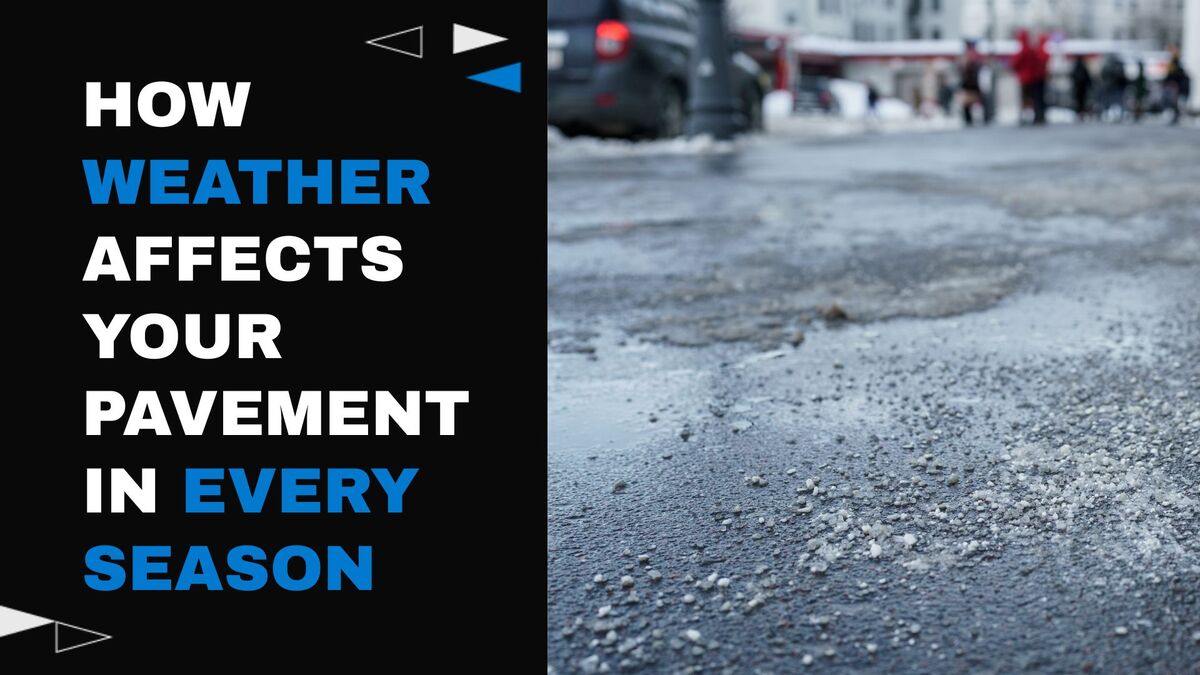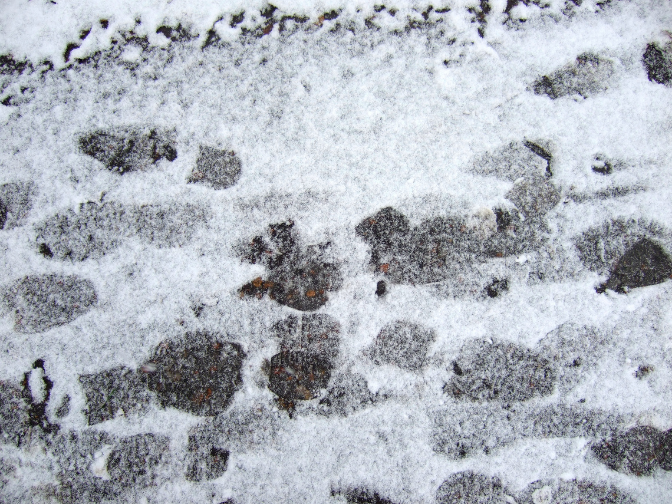How Weather Affects Your Pavement in Every Season

Ever notice your pavement doesn’t quite look like it used to? One surprise freeze, a few weeks of summer heat, or just a season of heavy rain can quietly weaken your surface until the damage is hard to ignore, and even harder to fix.
Maybe you’ve noticed cracks reappearing after winter or water pooling in the same spots every spring. What may look like surface-level wear is often a sign that the elements are already taking a toll on your investment.
Every season brings a different set of challenges. Freeze-thaw cycles can fracture the base, while extreme heat softens the surface, both speeding up the wear and leading to costly repairs sooner than you might expect.
With a better understanding of how climate and seasonal patterns affect asphalt and concrete, you can take more strategic steps to maintain durability, safety, and appearance throughout the year.
In this article, we’ll walk through the impact of each season and share smart ways to keep your pavement protected all year long.
Why Seasonal Weather Shouldn’t Be Overlooked
Pavement isn’t something you think about every day, but seasonal changes can impact it more than you realize. While it may seem durable on the surface, paved areas are constantly under pressure from environmental conditions. Over time, those conditions lead to wear that’s not always visible until real damage is done.
Pavement Is Constantly Exposed to the Elements
Throughout the year, surfaces expand and contract as temperatures rise and fall. Moisture seeps into the pavement, weakening the base underneath. UV rays, rain, snow, and rapid temperature swings all contribute to gradual deterioration, each leaving a lasting impact in its own way.
Ignoring Seasonal Wear Can Lead to Serious Problems
What starts as minor surface wear can quickly escalate. Cracks deepen, potholes form, and structural integrity weakens beneath the surface. Once water intrusion begins, it accelerates damage and leads to costly repairs. The longer these issues are left unaddressed, the more extensive and expensive they become.
.png)
Spring: Freeze-Thaw Damage and Drainage Issues
Spring is when the effects of winter become most visible. As snow melts and rain increases, pavement that made it through cold months without attention may now show signs of stress.
Melting Snow and Rain Reveal Winter Wear
Water finds its way into existing cracks and expands when temperatures fluctuate, loosening the sub-base and contributing to pothole formation. Salt and grime from plowing add to surface breakdown, while poor drainage can leave water pooling in the same problem areas.
What to Do in Spring
Taking action early in the season can prevent worsening damage.
- Schedule inspections to identify cracks and weakened spots
- Seal cracks before vegetation or water make them worse
- Clear drains and remove debris to promote proper runoff
.png)
Summer: Heat Stress and UV Exposure
While warm, dry weather might seem pavement-friendly, summer introduces new risks that affect both asphalt and concrete.
High Temperatures Soften Asphalt and Fade Surfaces
As temperatures climb, asphalt becomes more pliable, increasing the risk of rutting under heavy traffic. Concrete surfaces may expand and crack. At the same time, intense UV rays dry out essential binders, weakening the top layer of the pavement and reducing its lifespan.
What to Do in Summer
Summer is the ideal time for surface protection and responsive maintenance.
- Apply sealcoating to shield asphalt from UV damage
- Monitor high-traffic areas for signs of stress or rutting
- Repair soft spots or areas affected by oil and heat quickly

Fall: Shifting Temperatures and Early Cracking
Autumn may feel like a break from harsh conditions, but it's a key time for proactive maintenance. The shift from warm days to cool nights creates conditions that speed up surface deterioration.
Cooling Temps and Falling Leaves Create New Hazards
Leaves that pile up and retain moisture can cause decay on the surface. As nighttime temperatures drop, freeze-thaw activity can begin again, especially in already vulnerable areas. Small cracks expand and allow more water to enter.
What to Do in Fall
Fall preparation can help protect against winter’s harsh impact.
- Remove leaves and organic debris that trap moisture
- Perform crack sealing before temperatures drop further
- Schedule preventative services to strengthen pavement heading into winter

Winter: Snow, Ice, and Salt Exposure
Winter is the most punishing season for pavement. Extended freeze-thaw cycles, chemical exposure, and heavy snow equipment all take their toll.
Cold Weather Accelerates Pavement Breakdown
Water that infiltrates cracks freezes and expands, fracturing the pavement layer by layer. Deicing chemicals can erode surface materials, and snowplows, though essential, can scrape edges and create new points of failure.
What to Do in Winter
With the right approach, winter wear can be minimized.
- Use pavement-safe deicers that limit chemical damage
- Keep areas clear of snow through professional services
- Inspect surfaces mid-season for cracks or structural changes
Proactive Pavement Management All Year Long
Staying ahead of seasonal wear doesn’t mean overhauling your entire surface; it’s about consistency. Small, timely actions can dramatically extend the life of your pavement.
Year-Round Monitoring Makes a Big Difference
By keeping an eye on surfaces through regular inspections, you can catch issues before they grow. Strategic scheduling of services like sealcoating, crack filling, or drainage repair reduces long-term costs while improving performance.
How Pinnacle Protects Your Investment
Our team combines expert assessments with climate-aware strategies designed to extend the life of your paved surfaces. Maintenance programs are built around the specific needs of asphalt and concrete, supported by clear timelines and straightforward communication. No surprises, just smart planning.
Build Stronger Surfaces in Any Season with Pinnacle Paving
No matter the season, your pavement faces constant pressure from the elements. You don’t have to wait for problems to appear before taking action.
With a clear understanding of how weather affects your surfaces, and a proactive plan to address it, you can extend the life of your pavement, reduce long-term costs, and avoid unexpected repairs.
At Pinnacle Paving, we take seasonal wear seriously. Our experienced team helps you plan with smart, strategic maintenance designed for lasting results. From spring inspections to summer sealcoating and winter-safe deicing support, we’re here to help you keep your surfaces performing their best year-round.
Let’s make your pavement a long-term investment, not a recurring expense. Contact us today to schedule your consultation.

